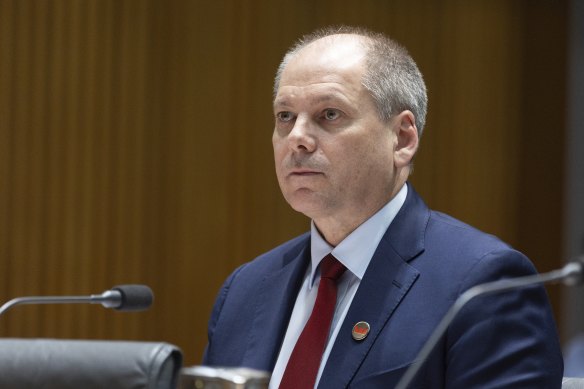Westpac says hardship has peaked as borrowers adjust to high rates
By Sumeyya Ilanbey
Outgoing Westpac chief executive Peter King says the number of borrowers in hardship has peaked as more customers adjust to high interest rates and cost-of-living pressures, as the banking giant said the economy was turning the corner.
Westpac on Monday reported profits in the year to September 30 fell 3 per cent to $7 billion, as the mortgage wars dragged down the bank’s earnings.

Westpac chief executive Peter King says the Australian economy is showing signs of strength. Credit: Alex Ellinghausen
The bank’s consumer division reported the sharpest decline after its net profits tumbled 17 per cent to $2.2 billion, “reflecting intense mortgage competition”. That slide was largely offset by Westpac’s business and wealth arm, where profits climbed 13 per cent to $2.4 billion, on the back of increased lending to agriculture, health and professional services companies.
King said that while elevated interest rates were hammering some customers, there were positive signs the economy was recovering, noting consumer sentiment was at its highest level in 2½ years.
“We did see hardship arrangements peak in June, and they have come down. So what do I put that down to? I think people have got used to the high level of interest rates and working through cost-of-living [pressures]. We had 47,500 hardship packages during the year, the majority of people required three months to work through their help period,” said King, who delivered his final financial results at the bank.
The proportion of Westpac customers 30 days behind on their repayments has increased 3 basis points to 1.8 per cent, while that of those three months behind has lifted 2 basis points to 1.1 per cent. The proportion of customers who are two years ahead on their mortgages rose 2 percentage points to 24 per cent and 17 per cent of borrowers are six months ahead.
Charges for impaired loans fell from 9 basis points to 7 basis points in a year.
King, who will be replaced by Anthony Miller as chief executive next month, said the most recent data, which takes in the period to mid-October, showed card spending had recovered. Quarterly growth was 1.5 per cent. He said Westpac customers had also been saving their stage 3 tax cuts and that they had increased their mortgage offset balances from $57 billion to $63 billion in a year.
The most recent Australian Bureau of Statistics household spending data shows discretionary spending in September fell 0.2 per cent month on month, while non-discretionary spending rose 0.2 per cent. An ANZ-Roy Morgan survey last week also showed consumer confidence stayed above the mark of 85 for a second consecutive week, the first time since January 2023.
Westpac expects the Reserve Bank of Australia to cut the cash rate early next year from its current level of 4.35 per cent, and is forecasting 100 basis points throughout 2025. It is also forecasting unemployment to rise from 4.3 per cent to 4.6 per cent, and the economy to grow by 1.5 per cent to 2.5 per cent.
Westpac’s net interest margin, a key measure of profitability comparing banks’ funding costs with what they charge for loans, improved in the second half on the back of more profitable lending, to 1.97 per cent.
The bank’s closely watched operating expenses, a key focus for analysts, jumped 6 per cent to $10.9 billion on the back of rising wages and technology costs.
Westpac delivered a higher final dividend of 76¢ a share, up from 72¢ a year earlier. It upped its buyback by $1 billion but it did not issue a special dividend as analysts had forecast.
Opal Capital Management chief investment officer Omkar Joshi said Westpac’s results were slightly better than expected, but the high interest rate environment continued weighing down borrowers.
“We’ve had some time to get used to a higher interest rate environment but I would say there’s an element of people waiting for rate cuts,” Joshi said. “Trading updates from retailers, and even anecdotal feedback, [suggests] that it does feel like things are slowing down from a consumer perspective.”
UBS head of Australian bank research John Storey said there was some disappointment Westpac did not announce a special dividend, but that could be offset by the expanded buyback scheme.
“The underlying [net interest margin] trends we think look encouraging, although a period of higher than expected cost growth might dampen some of this benefit,” Storey said.
Westpac shares rose 0.9 per cent to $32.40.
The Business Briefing newsletter delivers major stories, exclusive coverage and expert opinion. Sign up to get it every weekday morning.